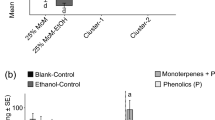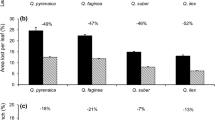Summary.
Following herbivory, induced responses involving plant secondary metabolites have been reported in a number of tree species. Although a wide range of plant secondary metabolites appear to operate as constitutive plant defences in trees belonging to the Eucalyptus genus, no induced responses have as yet been reported following foliar-chewing insect damage. We empirically tested whether branch defoliation (artificial and larval) of 2-year-old Eucalyptus globulus Labill. trees altered the abundance of specific plant secondary metabolites immediately (3 months after initial larval feeding) and 8 months after the cessation of larval feeding. Metabolites assayed, included essential oils, polyphenolic groups and foliar wax compounds and in all cases their abundance was not significantly altered by defoliation. However, the level of foliar tannins after 3 months of larval feeding did display a trend that suggested elevated levels as the result of defoliation, though this trend was not evident 8 months later, indicating that, if real, the response was a rapid and not a delayed induced response. The level of foliar tannins was also negatively correlated to both average larval survival and average percentage branch defoliation, suggesting that foliar tannins may operate as toxins and/or anti-feedants to M. privata larval feeding.
Similar content being viewed by others
Author information
Authors and Affiliations
Corresponding author
Rights and permissions
About this article
Cite this article
Rapley, L.P., Allen, G.R., Potts, B.M. et al. Constitutive or induced defences - how does Eucalyptus globulus defend itself from larval feeding?. Chemoecology 17, 235–243 (2007). https://doi.org/10.1007/s00049-007-0382-z
Received:
Accepted:
Published:
Issue Date:
DOI: https://doi.org/10.1007/s00049-007-0382-z




